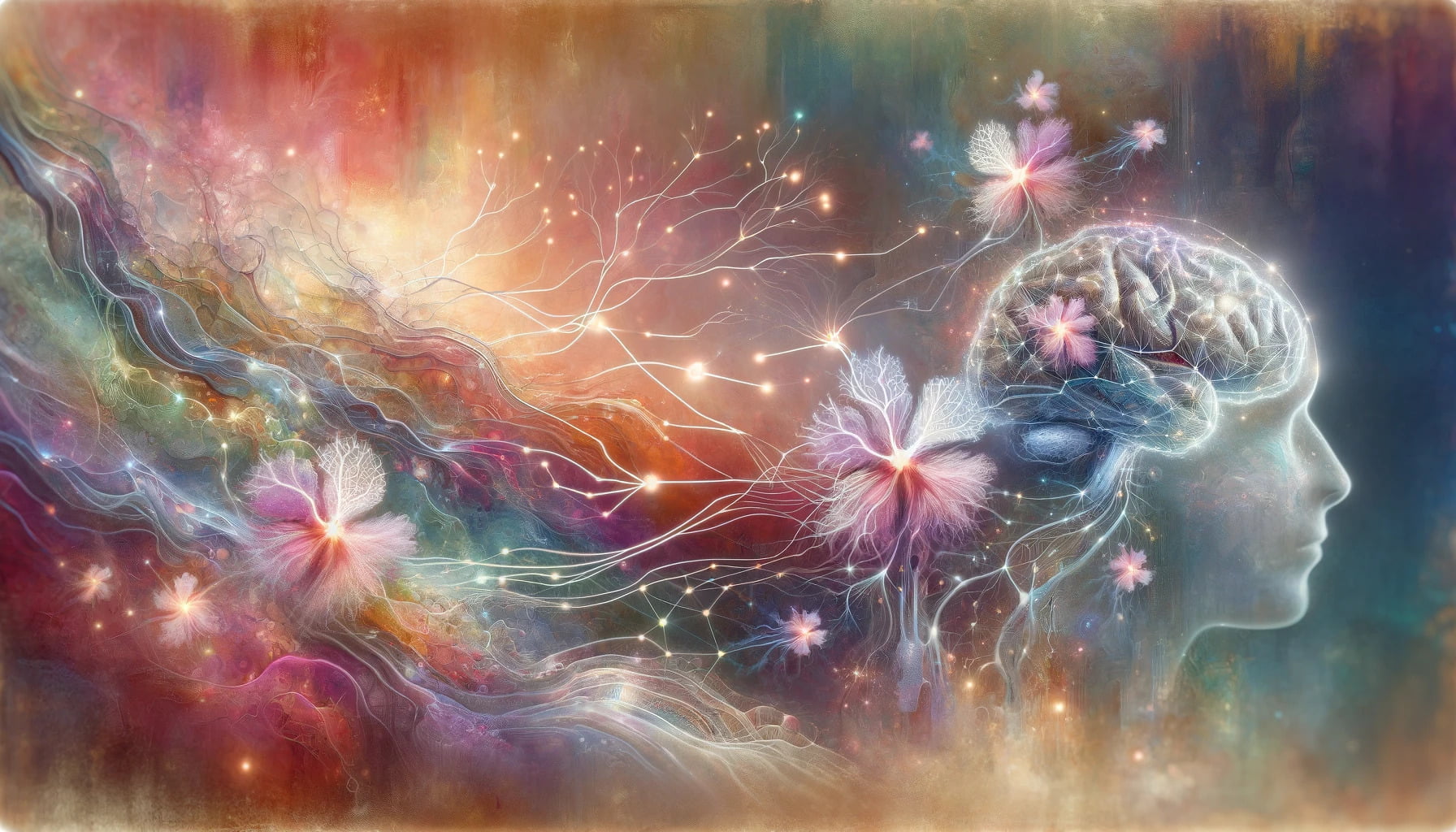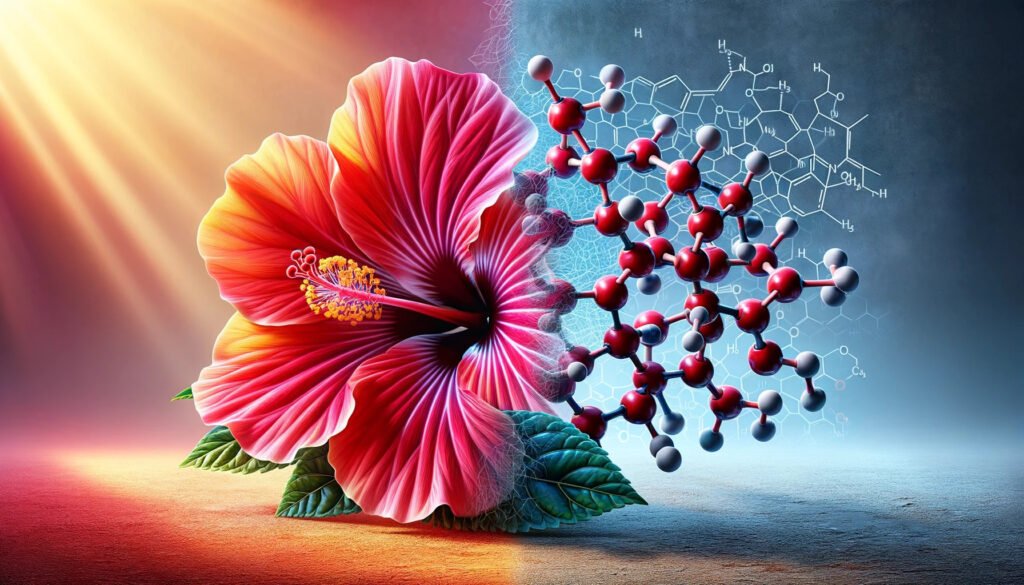
Hibiscus (Hibiscus sabdariffa), a colorful flowering shrub in the Malvaceae family, is more than just an ornamental plant.
Recent research suggests that hibiscus may offer cognitive benefits, making it a promising natural nootropic.
This article explores how hibiscus contributes to learning and memory, helps with mood management, improves focus, and supports neuroprotection.
Table of Contents

What is Hibiscus?
Hibiscus (also known as rose mallow, china rose, althea, rose of sharon) is a genus of flowering plants in the mallow family, Malvaceae.
It includes several hundred species that are native to warm-temperate, subtropical, and tropical regions throughout the world.
Hibiscus plants are known for their large, showy flowers found in a variety of colors, including red, pink, white, and yellow. Many hibiscus species are used as ornamental plants, but some also have medicinal uses.
The most commonly used species for medicinal purposes is hibiscus sabdariffa, also known as roselle or red sorrel. The dried calyces of this plant are used to make herbal teas, jams, and supplements.
Hibiscus tea has a tart, cranberry-like flavor and is a rich source of antioxidants.
What Are the Different Types of Hibiscus Plants?
There are several hundred species of hibiscus, but some of the most well-known include:
- Hibiscus syriacus (Rose of Sharon): A hardy, deciduous shrub native to Asia
- Hibiscus moscheutos (Swamp mallow): A perennial wetland plant native to the eastern United States
- Hibiscus mutabilis (Confederate rose): A shrub or small tree native to southern China
- Hibiscus rosa-sinensis (Chinese hibiscus): An evergreen shrub native to tropical Asia
- Hibiscus cannabinus (Kenaf): An annual or biennial herbaceous plant native to southern Asia
What Are the Bioactive Compounds in Hibiscus?
Hibiscus contains several bioactive compounds that contribute to its medicinal properties:
- Anthocyanins: Water-soluble pigments responsible for the red color of hibiscus calyces; possess antioxidant and anti-inflammatory properties
- Organic acids: Hibiscus is rich in citric acid, malic acid, and tartaric acid
- Polyphenols: Compounds such as quercetin, gossypetin, and sabdaretin; exhibit antioxidant effects
- Flavonoids: Hibiscus contains flavonoids like hibiscitrin and gossypitrin
What is the Bioavailability of Hibiscus?
The bioavailability of hibiscus compounds varies depending on the specific compound and the form of consumption (e.g., tea, extract, or capsule).
The bioavailability of anthocyanins from hibiscus tea is around 1.5%.
However, the bioavailability of polyphenols and flavonoids is higher, ranging from 10-50%.

What are the Cognitive Benefits of Hibiscus?
Hibiscus has been studied for its potential cognitive benefits, including:
| Benefit | Mechanism |
|---|---|
| Improved focus and attention | Modulation of the neurotransmitter acetylcholine |
| Improved memory and learning | Antioxidant and anti-inflammatory effects |
| Reduced anxiety and depression | Modulation of neurotransmitters like serotonin and GABA |
| Neuroprotection | Reduction of oxidative stress and inflammation in the brain |
How Does Hibiscus Contribute to Learning and Memory?
Hibiscus contains several compounds that may enhance learning and memory.
According to a study from the Indian Journal of Pharmacology, an extract of Hibiscus rosa-sinensis improved memory retention in rats, possibly due to its antioxidant properties.(1)
The flavonoids in hibiscus, such as quercetin and anthocyanins, have been shown to promote neurogenesis (the growth of new brain cells) in the hippocampus, a brain region critical for learning and memory.(2)
Key compounds in hibiscus that boost learning and memory:
- Quercetin
- Anthocyanins
- Polyphenols
How Does Hibiscus Help With Mood Management?
Hibiscus may help regulate mood by influencing neurotransmitters like serotonin and GABA.
Another study by the Indian Journal of Pharmacology found that Hibiscus rosa-sinensis extract had antidepressant-like effects in mice, comparable to the drug fluoxetine.(3)
The flavonoids and anthocyanins in hibiscus have also been shown to reduce anxiety and promote relaxation.
Hibiscus improves mood by:
- Increasing serotonin levels
- Enhancing GABA activity
- Reducing cortisol (stress hormone)
How Does Hibiscus Improve Focus?
Hibiscus may improve focus and attention by increasing acetylcholine, a neurotransmitter involved in learning, memory, and attention.
A study demonstrated that anthocyanins from hibiscus increased acetylcholine release in rat brain slices.(4) The antioxidants in hibiscus, such as vitamin C, may also help reduce oxidative stress and inflammation in the brain, which can impair cognitive function and focus.
Ways hibiscus enhances focus:
- Boosting acetylcholine levels
- Reducing oxidative stress
- Combating neuroinflammation
How Does Hibiscus Support Neuroprotection?
Hibiscus supports neuroprotection through its potent antioxidant and anti-inflammatory properties.
The plant is rich in bioactive compounds like anthocyanins, polyphenols, and organic acids, which scavenge harmful free radicals and reduce oxidative stress in the brain.
Oxidative stress and chronic inflammation are major contributors to neurodegenerative diseases like Alzheimer’s and Parkinson’s. By combating these damaging processes, hibiscus may help protect brain cells and maintain healthy cognitive function as we age.
A study from 2023 found that hibiscus extract protected rat brains from aluminum-induced oxidative stress and neurotoxicity. The authors suggested that the neuroprotective effects of hibiscus could be attributed to its high content of antioxidants and anti-inflammatory compounds.(5)
Furthermore, multiple studies highlight the potential of polyphenols to prevent and treat neurodegenerative diseases.(6)
The researchers noted that these compounds could cross the blood-brain barrier and exert neuroprotective effects by modulating signaling pathways involved in neuroinflammation and neuronal survival.

What Are The Nootropic Uses of Hibiscus?
Hibiscus, known for its vibrant flowers and health benefits, also has potential nootropic uses that can enhance cognitive function. Here are some key nootropic uses of hibiscus:
- Antioxidant Properties: Hibiscus is rich in antioxidants, which help protect brain cells from oxidative stress and damage. This protection can support overall brain health and cognitive function.
- Anti-Inflammatory Effects: Chronic inflammation is linked to cognitive decline and neurodegenerative diseases. Hibiscus has anti-inflammatory properties that may help reduce inflammation in the brain, promoting cognitive health.
- Improved Circulation: Hibiscus can help improve blood circulation. Better circulation ensures that the brain receives an adequate supply of oxygen and nutrients, which is essential for optimal cognitive function.
- Neuroprotection: Some studies suggest that hibiscus may have neuroprotective effects, potentially protecting the brain from damage and supporting cognitive function.
- Mood Enhancement: Hibiscus has been traditionally used to help reduce symptoms of anxiety and depression. By promoting a positive mood, hibiscus can support better cognitive performance and mental clarity.
- Support in Metabolic Health: Hibiscus has been shown to help regulate blood sugar levels and cholesterol. Better metabolic health is linked to improved cognitive function.
How To Use Hibiscus for Cognitive Enhancement?
Hibiscus can be consumed in several forms for cognitive enhancement:
| Form | Dosage |
|---|---|
| Tea | Steep 1-2 teaspoons of dried hibiscus calyces in hot water for 5-10 minutes, then strain and drink. |
| Extract | 100-500 mg daily |
| Capsules | Take as directed on the product label. |
Can Hibiscus be Used in a Nootropic Stack?
Yes, hibiscus can be incorporated into a nootropic stack for its antioxidant, anti-inflammatory, and neuroprotective properties. It may pair well with other nootropics that target similar mechanisms or cognitive functions, such as:
- Bacopa monnieri: May enhance the memory and learning benefits of hibiscus
- L-theanine: May synergize with hibiscus to promote relaxation and reduce anxiety
- Omega-3 fatty acids: May complement the anti-inflammatory effects of hibiscus
When creating a nootropic stack, start with low doses of each ingredient and monitor your response.
Consult a healthcare provider before combining nootropics to ensure safety and avoid potential interactions.
What Are the Side Effects and Risks of Using Hibiscus?
Hibiscus is considered safe when consumed in normal amounts as a tea or supplement. However, some potential side effects and risks include:
- Lowered blood pressure: Hibiscus may have a blood pressure-lowering effect, which could be a concern for individuals with already low blood pressure or those taking antihypertensive medications.
- Allergic reactions: Some people may be allergic to hibiscus, experiencing symptoms like itching, swelling, and difficulty breathing.
Who Should Avoid Hibiscus?
Certain individuals should exercise caution or avoid hibiscus:
- Pregnant women: There is limited research on the safety of hibiscus during pregnancy, so it’s best to avoid it as a precaution.
- People with low blood pressure: As hibiscus may lower blood pressure, those with already low blood pressure should consult a healthcare provider before using it.
What Are The Potential Interactions With Hibiscus and Medication?
Hibiscus may interact with several medications:
- Antihypertensive drugs: Hibiscus may enhance the blood pressure-lowering effects of these medications, potentially causing hypotension.
- Diuretics: Hibiscus may increase the diuretic effect, leading to electrolyte imbalances.
- Aspirin: Hibiscus may increase the risk of bleeding when taken with aspirin.
Always consult a healthcare provider before combining hibiscus with any medication.
- Nade, Vandana S et al. “Cognitive enhancing and antioxidant activity of ethyl acetate soluble fraction of the methanol extract of Hibiscus rosa sinensis in scopolamine-induced amnesia.” Indian journal of pharmacology vol. 43,2 (2011): 137-42. doi:10.4103/0253-7613.77347↩
- Cichon, Natalia et al. “Flavonoids as a Natural Enhancer of Neuroplasticity-An Overview of the Mechanism of Neurorestorative Action.” Antioxidants (Basel, Switzerland) vol. 9,11 1035. 23 Oct. 2020, doi:10.3390/antiox9111035↩
- Shewale, Pallavi B et al. “Antidepressant-like activity of anthocyanidins from Hibiscus rosa-sinensis flowers in tail suspension test and forced swim test.” Indian journal of pharmacology vol. 44,4 (2012): 454-7. doi:10.4103/0253-7613.99303↩
- Varadinova, Miroslava et al. “Effects of anthocyanins on active avoidance test of rats exposed to disruption of diurnal rhythm.” American journal of therapeutics vol. 20,2 (2013): 172-7. doi:10.1097/MJT.0b013e3182589188↩
- Efosa, John Osarenren et al. “Hibiscus sabdariffa calyx protect against oxidative stress and aluminium chloride-induced neurotoxicity in the brain of experimental rats.” Toxicology reports vol. 10 469-480. 17 Apr. 2023, doi:10.1016/j.toxrep.2023.04.008↩
- Atawodi, S E et al. “Polyphenol composition and antioxidant potential of Hibiscus esculentus L. fruit cultivated in Nigeria.” Journal of medicinal food vol. 12,6 (2009): 1316-20. doi:10.1089/jmf.2008.0211↩

